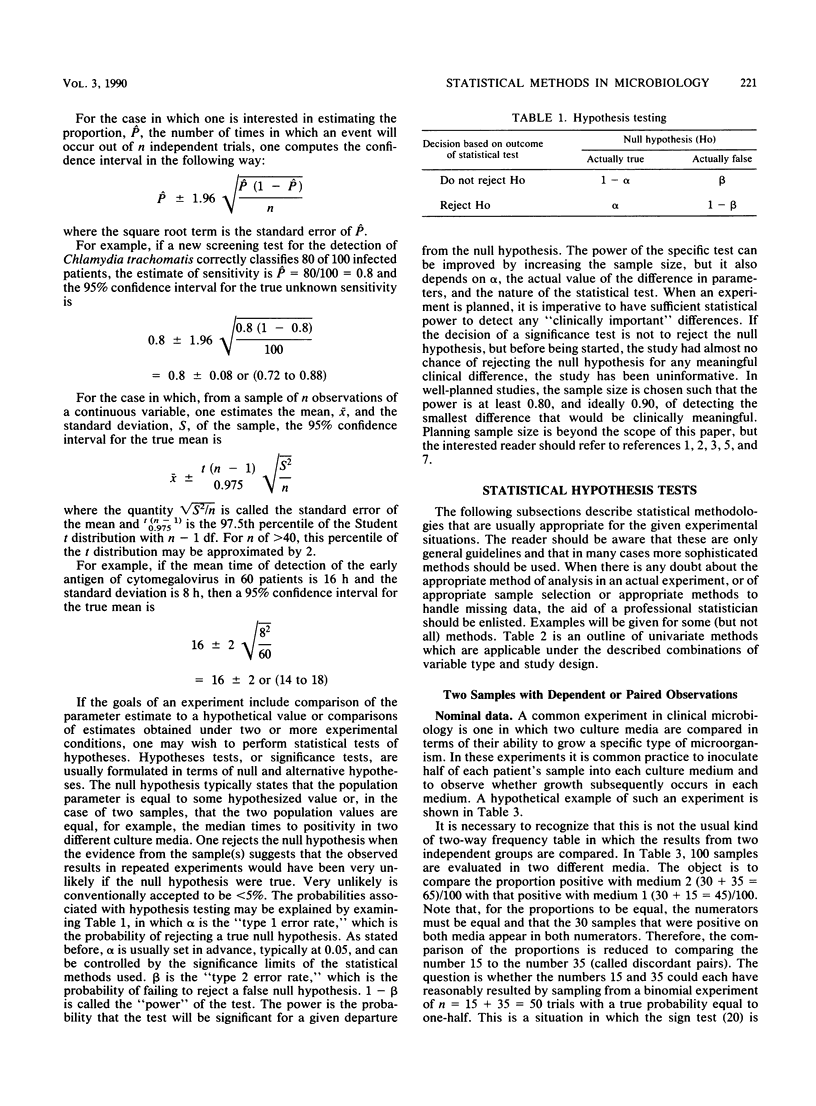Abstract
Statistical methodology is viewed by the average laboratory scientist, or physician, sometimes with fear and trepidation, occasionally with loathing, and seldom with fondness. Statistics may never be loved by the medical community, but it does not have to be hated by them. It is true that statistical science is sometimes highly mathematical, always philosophical, and occasionally obtuse, but for the majority of medical studies it can be made palatable. The goal of this article has been to outline a finite set of methods of analysis that investigators should choose based on the nature of the variable being studied and the design of the experiment. The reader is encouraged to seek the advice of a professional statistician when there is any doubt about the appropriate method of analysis. A statistician can also help the investigator with problems that have nothing to do with statistical tests, such as quality control, choice of response variable and comparison groups, randomization, and blinding of assessment of response variables.
Full text
PDF







Selected References
These references are in PubMed. This may not be the complete list of references from this article.
- Lachin J. M. Introduction to sample size determination and power analysis for clinical trials. Control Clin Trials. 1981 Jun;2(2):93–113. doi: 10.1016/0197-2456(81)90001-5. [DOI] [PubMed] [Google Scholar]
- McNeil B. J., Hanley J. A. Statistical approaches to the analysis of receiver operating characteristic (ROC) curves. Med Decis Making. 1984;4(2):137–150. doi: 10.1177/0272989X8400400203. [DOI] [PubMed] [Google Scholar]
- McNeil B. J., Keller E., Adelstein S. J. Primer on certain elements of medical decision making. N Engl J Med. 1975 Jul 31;293(5):211–215. doi: 10.1056/NEJM197507312930501. [DOI] [PubMed] [Google Scholar]
- Metz C. E. Basic principles of ROC analysis. Semin Nucl Med. 1978 Oct;8(4):283–298. doi: 10.1016/s0001-2998(78)80014-2. [DOI] [PubMed] [Google Scholar]
- Moses L. E., Emerson J. D., Hosseini H. Analyzing data from ordered categories. N Engl J Med. 1984 Aug 16;311(7):442–448. doi: 10.1056/NEJM198408163110705. [DOI] [PubMed] [Google Scholar]
- O'Brien P. C., Shampo M. A. 3. Graphic displays--scatter diagrams. Mayo Clin Proc. 1981 Mar;56(3):196–197. [PubMed] [Google Scholar]
- O'Brien P. C., Shampo M. A. Statistics for clinicans 4. Estimation from samples. Mayo Clin Proc. 1981 Apr;56(4):274–276. [PubMed] [Google Scholar]
- O'Brien P. C., Shampo M. A. Statistics for clinicians. 1. Descriptive statistics. Mayo Clin Proc. 1981 Jan;56(1):47–49. [PubMed] [Google Scholar]
- O'Brien P. C., Shampo M. A. Statistics for clinicians. 2. Graphic displays--histograms, frequency polygons, and cumulative distribution polygons. Mayo Clin Proc. 1981 Feb;56(2):126–128. [PubMed] [Google Scholar]
- O'Brien P. C., Shampo M. A. Statistics for clinicians. 5. One sample of paired observations (paired t test). Mayo Clin Proc. 1981 May;56(5):324–326. [PubMed] [Google Scholar]
- O'Brien P. C., Shampo M. A. Statistics for clinicians. 8. Comparing two proportions: the relative deviate test and chi-square equivalent. Mayo Clin Proc. 1981 Aug;56(8):513–515. [PubMed] [Google Scholar]


